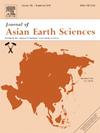泰国中部考光褶皱和冲断带二叠-三叠纪火成岩活动的地层、构造和构造背景
IF 2.7
3区 地球科学
Q2 GEOSCIENCES, MULTIDISCIPLINARY
引用次数: 0
摘要
尽管地球化学和地质年代学上确定了晚二叠世-晚三叠世火山弧背景,但由于缺乏连续的自然露头,印度支那地体西缘N-S Loei褶皱带(LFB)的二叠纪-三叠纪原生活动通常没有得到很好的详细描述。在趋势的南端,考光褶皱和冲断带(KKFTB)由于广泛的采石场活动,在地层和构造与火成岩活动的关系方面显示出显著的细节水平。本研究描述了这些露头关系,特别是:1)早二叠世(弧)火山活动与早二叠世深水明矾页岩互层的地层背景,2)早-晚二叠世Saraburi群沉积后的晚二叠世火山活动,3)早三叠世变形开始前的岩床和岩脉侵入Saraburi群(预运动)。4)中晚三叠世KKFTB主褶皱和逆冲期(后运动期)后的岩基、岩脉和水体侵入。由于层理和逆冲断层强度各向异性的强烈控制,二叠系碳酸盐岩的运动后侵入几何形状受到褶皱和逆冲几何形状的强烈影响。KKFTB与LFB的不同之处在于早二叠世时代和大量晚三叠世火成岩活动、东西向和早中三叠世褶皱和逆冲时代。这归因于KKFTB下二叠纪时期的一个向北俯冲阶段,当时南北印度支那之间的一个小海洋闭合,并先于最近的二叠纪-三叠纪向东俯冲,开始于统一的(N和S)印度支那西部边缘。本文章由计算机程序翻译,如有差异,请以英文原文为准。

Stratigraphic, structural and tectonic contexts of Permo-Triassic igneous activity in the Khao Khwang fold and thrust belt, central Thailand
Permo-Triassic igenous activity along the N-S Loei Fold Belt (LFB), on the western margin of the Indochina Terrane, is generally not well-described in detail due to poor, discontinuous natural outcrops, although geochemically and geochronologically a Late Permian-Late Triassic volcanic arc setting has been determined. At the southern end of the trend, the Khao Khwang Fold and Thrust Belt (KKFTB) displays a dramatic increase in the level of detail available regarding the stratigraphic and structural relationships with igneous activity due to widespread quarry activity. This study describes these outcrop relationships, in particular: 1) the stratigraphic context of Early Permian (arc) volcanic activity interbedded with Early Permian deepwater Alum Shales, 2) Late Permian volcanic activity following on from deposition of the Early-Late Permian Saraburi Group. 3) Intrusion of sills and dykes into the Saraburi Group prior to the onset of deformation in the Early Triassic (pre-kinematic). 4) Intrusion of sills, dykes and plutions in the Middle-Late Triassic after the main folding and thrusting episode of the KKFTB (post-kinematic). Post-kinematic intrusion geometries are strongly influenced by fold and thrust geometries in the Permian carbonates, due to the strong control by bedding and thrust fault strength anisotropies. The KKFTB differs from the LFB in the Early Permian timing and large volume of Late Triassic igneous activity, the E-W orientation and Early-Middle Triassic age of folds and thrusts. This is attributed to a phase of Permian-age northwards directed subduction below the KKFTB, when a small ocean between North and South Indochina closed, and preceded latest Permian-Triassic eastwards subduction commencing on the western margin of a united (N and S) Indochina.
求助全文
通过发布文献求助,成功后即可免费获取论文全文。
去求助
来源期刊

Journal of Asian Earth Sciences
地学-地球科学综合
CiteScore
5.90
自引率
10.00%
发文量
324
审稿时长
71 days
期刊介绍:
Journal of Asian Earth Sciences has an open access mirror journal Journal of Asian Earth Sciences: X, sharing the same aims and scope, editorial team, submission system and rigorous peer review.
The Journal of Asian Earth Sciences is an international interdisciplinary journal devoted to all aspects of research related to the solid Earth Sciences of Asia. The Journal publishes high quality, peer-reviewed scientific papers on the regional geology, tectonics, geochemistry and geophysics of Asia. It will be devoted primarily to research papers but short communications relating to new developments of broad interest, reviews and book reviews will also be included. Papers must have international appeal and should present work of more than local significance.
The scope includes deep processes of the Asian continent and its adjacent oceans; seismology and earthquakes; orogeny, magmatism, metamorphism and volcanism; growth, deformation and destruction of the Asian crust; crust-mantle interaction; evolution of life (early life, biostratigraphy, biogeography and mass-extinction); fluids, fluxes and reservoirs of mineral and energy resources; surface processes (weathering, erosion, transport and deposition of sediments) and resulting geomorphology; and the response of the Earth to global climate change as viewed within the Asian continent and surrounding oceans.
 求助内容:
求助内容: 应助结果提醒方式:
应助结果提醒方式:


